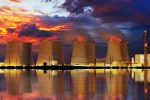VettaFi’s Evan Harp sat down with Sprott Asset Management CEO John Ciampaglia for a two-part interview. The first part covers the uranium market, where Sprott is a leader through the Sprott Physical Uranium Trust (SPUT, TSX: U.U ($US); U.UN ($CA)).
Evan Harp: Can you give me a broad overview of uranium?
John Ciampaglia: Many interesting things are happening in the uranium and nuclear power space right now. We are still in a bear market, trying to work through the Fed’s interest rate hikes and quantitative tightening. But what’s notable is that uranium stocks were one of the few sectors that bounced early in the summer. Although they did get caught in the Q2 downdraft, if you look at the performance of uranium mining equities since July 1, they’re up 30%. I can’t think of any other asset class up 30% over the summer.
I was talking to CNBC about this yesterday. The fundamentals are so interesting in uranium and nuclear right now that it has allowed the sector to decouple from the rest of the market and all the macro headwinds that markets are facing. I think this is interesting that in an environment where people are struggling to find positive returns this year, in this malaise that we’ve hit since April/May, uranium is one of the few sectors that has experienced a V-shaped recovery. But we haven’t yet seen the return of money flows into the uranium mining stocks, but I think that will come in due course.
What’s driving this positive performance? We believe it is the recognition of what we describe as a growing number of energy policy U-turns happening worldwide. Whether it’s California doing an about-face on Diablo Canyon Nuclear Power Plant, which was their last nuclear power plant — I love the fact that California has had power outages recently, and just last week it agreed to extend the operating license for Diablo Canyon, which produces 8% of the entire state’s electricity. California has now decided to extend Diablo’s operating license to 2030.
Just two weeks ago, Japan finally announced more nuclear reactor restarts. Why? Because there’s a global energy crisis going on right now, but in North America, we’re not experiencing it as much as in other parts of the world. For example, energy bills this winter are likely to double, but the reality is if you look at natural gas, it’s $9/MMBTU in North America right now. $9 may be high, but the price is $60 in Asia and $90 in Europe. You can imagine the scope of the shock those regions are having right now with natural gas prices, which directly impacts electricity prices.
We will have a second energy shock come when the winter starts and people start using natural gas for heating. They’re having major problems in Europe and Asia because they’ve been so overly reliant on Russia for natural gas, which we know is now being weaponized.
As you know, nuclear power is not politicians’ most politically friendly topic to rally behind. When your constituency has energy bills increasing five or 10 times, the tradeoff is, “Do I keep the nuclear power plant on?” or “How am I doing with my energy bill going up 10x?” Unfortunately, sometimes a crisis will force politicians to make the tough decision. That’s what’s happening. California; Japan; South Korea’s new prime minister had a complete U-turn on nuclear energy; India signaled that it wants to build more plants; China recently indicated that it could accelerate the build out of their nuclear reactors.
Then there is Germany, which we view as the poster child for a misguided energy policy. But Germany finally announced a day or two ago that it might keep two of its last three nuclear reactors on reserve, just in case it experiences an energy shortfall this winter.
In our view, what’s going on right now parallels what happened in the mid to late ’70s, when OPEC got control of the oil price. That was the catalyst for the first big pivot in energy policy that we saw in the West, and that energy policy was designed to reduce reliance on OPEC oil. That was the catalyst that spawned the buildout of most of the nuclear power plants in North America and Europe, and most of those power plants are still operating today.
Evan Harp: This is interesting to me. You had mentioned at the beginning of that you still felt like uranium was in a bear market, even though it’s up 30% this year at a time when the rest of the market is seeing red. Do you just see that as a prologue to bigger things for the space?
John Ciampaglia: We believe that uranium’s new bull market started over the last 18 months. The spot uranium price 18 months ago was in the high $20s per pound. Right now, we’re in the low $50s per pound. We’ve had a pretty big move, and most of that’s come in the last 15 months. This new bull market follows what we would describe as a nine-year bear market. We think we’ve finally broken free of that downtrend. What’s happening is that many companies and countries are announcing nuclear power plant extensions and the buildout of financial and regulatory support for nuclear energy, which is likely to create more demand for physical uranium. When the physical uranium price is higher, it provides a huge boost to the mining equities. Because without the higher price of uranium, you don’t have an incentive for uranium mining companies to turn on resumed production of the many uranium mines relegated to care and maintenance in the bear market.
We are now seeing mining companies, one after another, restarting mines that have been closed for five years. This is very healthy because the higher uranium means miners can make a profit and now utilities are coming to them saying, “Hey, we need to buy uranium from you.” That’s why the uranium equities have had this 30% bounce in the last two months. There are strong fundamentals and positive investor sentiment because of all the policy shifts. The U.S.’s Inflation Reduction Act is a good example of increased support for existing power plants, which got a $15 per megawatt hour tax incentive. These are small things, but they provide financial support to the existing fleet of nuclear reactors to make them more competitive.
We see tremendous change in nuclear policy and regulation, which bodes well for the price of physical uranium and uranium miners. This is a very interesting story, and I think it’s one of the few bright spots in the market.
The investor interest is coming back. We’ve been doing client calls with institutional investors in Asia, Hong Kong and Japan this week. They have been waking up and saying, “Hey, finally, Japan is making the tough decision to get more reactors because they’ve been dragging their feet for a very long time on this decision.” Until now, they have been dragging their feet because there wasn’t enough public support for politicians to support nuclear power. But with natural gas prices spiking, it’s like, “Hey, we don’t have a choice. We have to do this because of electricity in the winter.”
Evan Harp: I think that’s a really powerful story, especially considering Japan’s history with Fukushima and events in the past that have made nuclear a harder pitch there. If there’s political will for expansion of nuclear in Japan, that says a lot. In terms of developing tech, there are breakthroughs in nuclear fusion. Is there a danger that kind of tech could cut the uranium bull market off? Or do you see that as not necessarily being a concern right now?
John Ciampaglia: Nuclear fusion is like the magic bullet to everything. Essentially, if you could figure out how to do it on a large scale, you would be able to replace the entire oil and gas business. The reality is that nuclear fusion is far from large-scale commercialization. You may hear that a research lab or such-and-such university is doing experiments, but they’re only able to create fusion reactions that last less than 60 seconds. It’s interesting what they’re doing, but it is far from becoming viable.
I think what’s more interesting is the development of small modular reactors (SMRs), sometimes referred to as advanced modular reactors (AMRs). Many countries, including the United States, France, Canada, Japan and South Korea, recognize that SMRs are a viable technology to support the development, commercialization and construction of nuclear power options.
SMRs help address certain problems with nuclear power plants. For example, traditional nuclear power plants are big in terms of power generation and are most suitable for big cities. They don’t work in smaller metropolitan areas because they’re expensive to build. They’re always over budget and schedule. To put it into context, a typical power plant is about 1 gigawatt, equal to 1000 megawatts. A small modular reactor can be anywhere from 77 to 300 megawatts, so very small. An SMR can be brought to a location and assembled on site. They’re simpler to build and they’re more versatile for different jurisdictions. Currently, 70 designs are being worked on globally, and It’s a bit of a race. You’ve got GE Hitachi and Kazakhstan working on a plan; you’ve got NuScale, TerraPower and even Rolls-Royce working on designs. A number of different governments are supporting the development of SMR technology, because governments like the United States have realized that the future will be in hundreds, or perhaps thousands, of these smaller reactors.
If the SMR technology gets figured out and can be commercialized, the next question is, where do you put them? As you know, public resistance is high given NIMBYism, for one. But what if thousands of sites exist today that would host a small modular reactor? Where would those sites be? The sites could be located where existing coal power plants now sit, many of which are destined to close over time. What happens when one of these coal plants, for example, has 600 people employed; when these workers lose their jobs, the whole town dies. You take the site where the coal plant is and retool it for an SMR. All the power lines and transmission infrastructure is already there and doesn’t have to be built. You then retrain the workforce, creating hundreds of new construction jobs. Voilà, you get rid of your coal plant and replace it with an SMR.
Evan Harp: That is a compelling series of events, and it makes a lot of sense. I have one more question to bridge us between nuclear power and gold. That is, what do you see as the effects of Russian sanctions in the long term? Russia, of course, is a place that does quite a bit in terms of uranium processing and uranium mining. It also has a footprint in precious metals.
John Ciampaglia: It’s having a profound impact on the uranium market because, as you correctly pointed out, Russia is a player in global uranium production. Most of that production is not in Russian territory, it’s through joint ventures with Kazakhstan. But Russia plays an important role because they are a meaningful provider of conversion and enrichment services in the nuclear fuel chain. Russia accounts for about 40% of the global capacity available today for enrichment and almost 30% for conversion services.
Why does Russia control these important services? The answer is that when the uranium bear market took its hardest bite out of the sector, many companies in the United States declared bankruptcy. A major conversion facility in Illinois has been closed since 2017 because prices were too low. You’ve got capacity in the West that’s been either closed or curtailed. We offshored these services to Russia because it was cheaper. It worked great — utilities got affordable services that allowed consumers to have cheaper electricity, but that works only when everybody’s friends. Now that supply chain is all messed up because the utilities in the United States and Western Europe are saying, “Okay, I don’t want to sign any new contracts with Russia. But I can’t cancel my contracts with them today because there’s no alternative supplier.” Suppliers in the West are now saying to utilities, “Look, we’ll restart, but we need to have the right price. More importantly, we need to have long-term contracts because we don’t want to make these huge capital investments, hire people, and then we’re friends again with Russia and you move all your business back to them. No, thanks.”
It has been a delicate situation with the U.S. Department of Energy in the last couple of months, which has said to Congress, “We’re worried about this and we’d like $4 billion of funding because we need to facilitate this transition away from Russia.” The U.S. relies on Russia for about 20% of its enriched uranium. Although it is not a huge amount, 20% is important because you don’t want your power plant to run out of fuel. The U.S. government is sufficiently concerned about this transition that it’s asked for billions of dollars in funding.
We also believe that the U.S. government wants to build a strategic reserve of uranium as it has with oil, but this plan is still in its infancy. The bottom line is that uranium is a critical mineral, and governments now realize that the supply chain is more vulnerable than they previously thought.
For more news, information, and strategy, visit the Gold & Silver Investing Channel.








